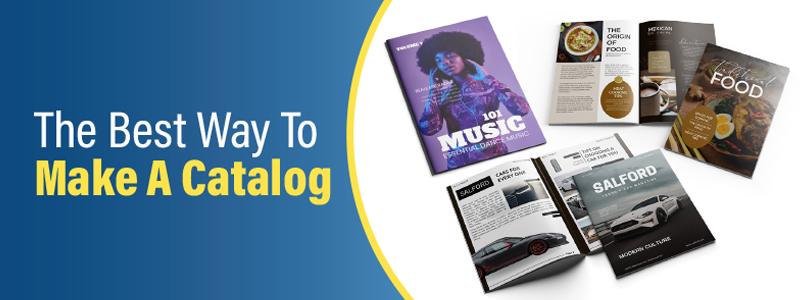
Catalogs are more than marketing materials—they’re powerful tools that connect you with your audience and highlight your brand in a unique way. A well-designed and carefully crafted catalog will attract new customers, increase brand loyalty, and strengthen current customer relationships.
Creating an effective catalog that meets its full potential can be overwhelming. That’s why we created a step-by-step guide to help you create a catalog for your business that will appeal to your audience and generate amazing results. Use these expert tips and best practices to plan, gather content, design, and print a powerful catalog that makes a lasting impact on your audience.
How to Make Your Own Catalog
Creating a catalog can be a valuable marketing tool for showcasing your products and attracting potential customers. To get started:
- Determine the purpose of your catalog and gather all necessary product information, such as composition, dimensions, pricing, and customer testimonials.
- Plan your catalog's structure and layout, considering factors such as categories, product features, and visual design.
- Design your catalog using software and templates, highlighting your products' unique features and benefits.
- Publish your catalog online or download it for printing and distribution.
Below is an in-depth guide to the above steps. By following these steps, you'll be well on your way to creating a professional-looking catalog that effectively delivers your message.
Step 1: Determine the Purpose of Your Catalog
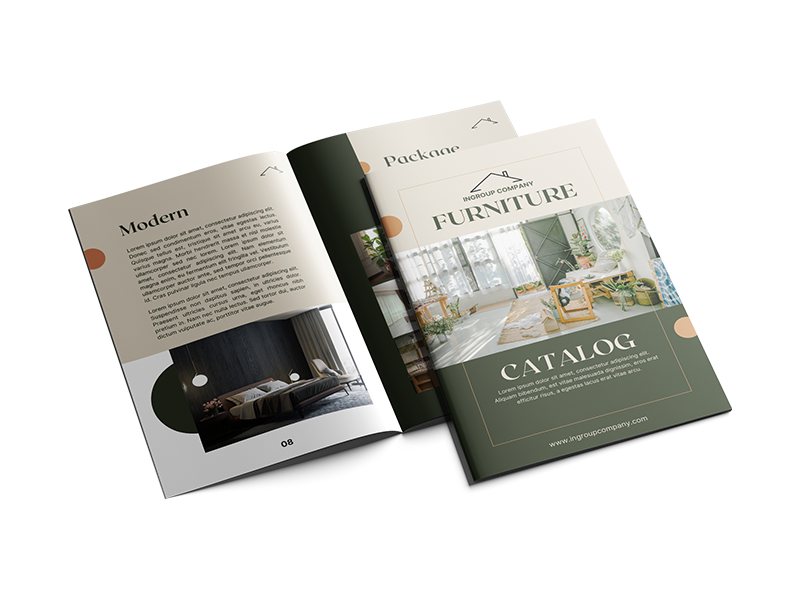
When creating a catalog, it's important to begin with the end goal in mind. Before you begin designing it, decide what purpose your catalog will serve for your audience.
Ask yourself: What message do you want your catalog to deliver? Will it advertise products or services? Will it serve as a calendar, guide, or introduction to your business? Determining the intended purpose of your catalog is essential, whether it's a product listing or an informational, promotional, or service listing catalog.
By identifying your catalog's goal, you can ensure that every component of its creation, from the design to the content on each page, supports that purpose. Take time in this step to carefully consider what you want to achieve with your catalog marketing, and let that guide you through the next steps of creating a catalog for your business.
Step 2: Figure Out Your Budget
Catalog printing may be slightly more expensive than brochures or postcards, but it's less expensive than you may think. In fact, there are some proven ways for companies on a tight budget to create cheap catalogs that still provide the benefits of catalog marketing. Regardless of your budget, determining your spending limit will help you select the right size, page count, paper stock, finishes, and direct mail marketing strategy for your catalog.
Whether you have limited resources or a large budget, it's important to recognize the value of catalog marketing. They offer one of the highest returns on investment and help connect your audience with your brand. You can create a successful catalog that fits your budget with careful planning and the right catalog specifications.
Step 3: Gather Your Catalog Content
Outlining is crucial in creating a catalog. Gather and organize your content before laying out your design from the front cover to the back. Your content should include images, products, services, company information, testimonials, table of contents, and contact information. A well-structured outline ensures that every element aligns with your intended purpose, making managing your catalog's content easier.

Front Cover
Your catalog's cover is the first thing your audience will see, and it will be the deciding factor in whether they engage with it or toss it aside. The cover should be eye-catching and persuasive enough to entice your audience to pick it up and flip through the pages.
Consider the design elements and messaging you will use to create an effective catalog cover. Make sure to include your brand's name, vibrant colors, imagery that aligns with your brand's identity, and intriguing language that speaks to your target audience.
Table of Contents
No matter the size of your catalog, a table of contents or index is essential in helping your readers navigate its pages.
A well-crafted table of contents will show your audience that you value their time and interests. It serves as a roadmap that guides them to the pages most relevant to their needs, making the catalog browsing experience more enjoyable. Including a user-friendly table of contents can enhance your readers' engagement with your catalog, thus driving more sales and revenue.
Introduction Pages
Catalogs are like books; they tell a story and help introduce your brand and its message to your readers. An introduction is essential to any good book, and it is no different for catalogs.
For catalogs selling and listing products or services, the introduction pages are a perfect place to include advertisements and promotions to excite the reader about the following pages. These pages can also act as advertising space for informational catalogs and other types of catalogs, but that might not always be the best option. In this case, the introduction pages are the perfect place to include a summary of who your brand is or any intriguing content that grabs the reader's attention and moves it further.
Main Content
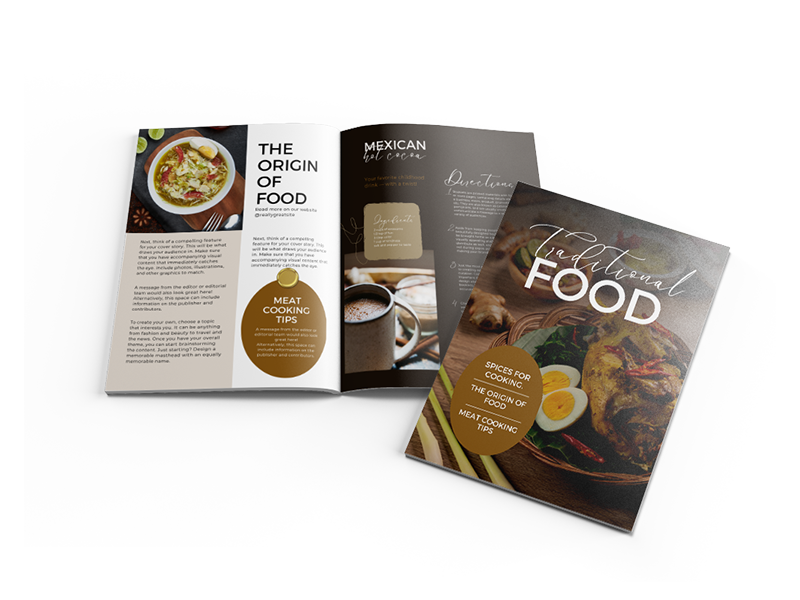
To create the main content section of your catalog, you must identify the key products, services, or company details you want to showcase. Begin by determining the main categories or themes you want to focus on and gather all the necessary information, such as descriptions, product specifications, and images. You can collect additional content, such as case studies, testimonials, or paid ads.
As you gather your content, plan out the flow of your pages. Each page should emphasize the content or products you want to prioritize so your audience can easily engage. To provide an organized and efficient experience, segment your pages and content based on your table of contents.
Final Pages
The final pages of your catalog are where you can tie everything together to create a lasting impression on your audience. You can use this space to strengthen your brand image and remind your readers of why they engaged with your catalog in the first place. Including customer reviews or stories about your company is a great way to build trust. You could use this space to provide contact information, your website details, or social media handles to encourage further engagement with your brand.
Guide For How to Order
Catalogs are an excellent way for shoppers to discover new products and make informed purchasing decisions from the comfort of their own homes. While order forms mailed in have become less common in catalogs, they can still be useful tools for some readers who may not be tech-savvy. Even if you choose to include an order form, be sure to include a website URL or QR code on the last page of your catalog. This will make it easy for readers to visit your website to learn more or place an order online. A recent survey showed that 60% of shoppers who received a catalog visited the website of the company that sent the catalog. So, it's important that you make it as easy as possible for readers to visit your website from your catalog.
Back Cover
While the front cover is important for grabbing your audience's attention, the back cover of your catalog is equally important for providing a great first impression. When gathering the content for the back cover, consider including information and design elements that complement the front cover and provide insight into the products or services inside.
Step 4: Choose High-Quality Images

It is essential to include high-quality images in your catalog to engage readers and drive sales. Poor-quality images, like low-resolution or over-saturated photos, can turn readers away before they even have a chance to read your offer. Just like static on the radio, unappealing images drive readers away. To ensure your imagery is printed crisp and vibrant, images should be converted to CMYK color model, be at least 300 dpi in resolution, and never scaled up more than 20%. Images that need to be scanned, like line art or graphics, should be at least 1200 dpi for the best results.
Keep in mind that it's not just technical details that matter – the content of your images should also reflect your catalog copy, brand, and target audience. Consider using images that show your products in use, highlight unique features, or highlight customer experiences. Working with a professional photographer or graphic designer can help you create high-quality images to make your catalog stand out. After all, your images are the first thing readers see and can make or break their decision to read on and ultimately make a purchase.
Step 5: Choose the Right Catalog Size
Choosing the right size for your catalog is extremely important. While it may be tempting to design and print a smaller catalog, such as 5.5 x 8.5 or 6 x 9, to save money, this can backfire if you have a lot of content to include. A larger printed catalog, such as 8.5 x 11 or 9 x 12, will provide more space for your content, which can prevent pages from feeling overwhelming. This extra space also allows for more negative space, which helps frame your product images, service descriptions, and other content in an appealing way.
Step 6: Decide on How Many Pages You’ll Need

The page count of your catalog will depend on the binding option you choose and the amount of content you plan to include. For saddle-stitched bound catalogs—the most popular binding method—your page count needs to be divisible by 4, as each sheet of paper provides 4 pages. It's important to remember that saddle-stitched catalogs have limitations on the number of pages. When there are too many pages, the inner pages can start to stick out further from the cover, causing what's known as "page creep." Perfect binding is ideal for catalogs with a page count larger than 96 pages. With perfect binding, there is no need to worry about page creep, as the cover is printed larger to accommodate the thickness of the inner pages when stacked together.
Step 7: Choose the Right Catalog Design Software
When designing a catalog, Adobe platforms such as InDesign are the ideal and preferred choice, as they package everything needed for printing, including image files, fonts, and PDFs with bleed. However, several other catalog design software options such as Scribus and Canva, are also suitable. Regardless of your design platform, it's important to export your catalog design as a PDF file to ensure the best quality when printed and to allow your files to move smoothly through the print production process.
Step 8: Create an Eye-Catching Catalog Cover
Now that your layout is set up, it's time to start assembling your catalog content within your design platform, beginning with the cover.

As we mentioned in step 3, your catalog's front and back cover will determine whether your audience reads or tosses it aside. That's why making a solid first impression is essential. Include irresistible deals, stunning images, vibrant colors, and eye-catching and easy-to-read fonts to capture the reader's attention.
However, ensuring that your cover design isn't too cluttered is essential. Leaving some negative space will allow your design to "breathe," conveying a sense of freshness and excitement rather than overwhelm and stress. This will also help create an engaging and welcoming experience for your audience.
Step 9: Build Your Catalog Pages
Each page may be a separate component of your catalog, but it should all flow cohesively together. A balanced image-to-copy ratio is important to achieve this goal. Break up your text into sections with headlines and subheadings, and distribute your images evenly across the pages. Think of each page as a grid, and carefully lay out your images and copy within the grid in an evenly distributed way to create a smooth reading experience.
If you're concerned about the design process of your catalog, working with a graphic designer can be a great solution. A designer will be able to assist with any issues you run into or will be able to help create a professional and eye-catching catalog design that is sure to generate amazing results.
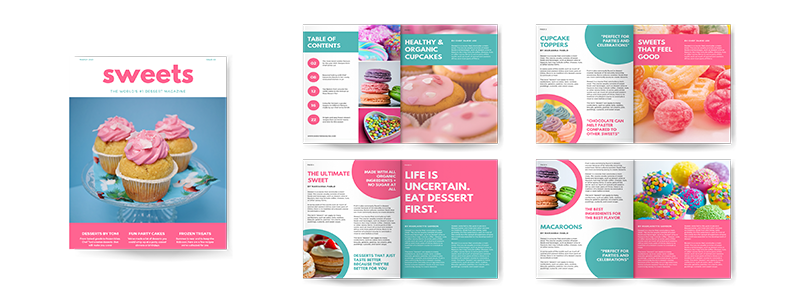
Step 10: Include a Clear Call to Action
A call to action (CTA) is a powerful marketing tool that uses compelling language to encourage the viewers to take a specific action. With catalogs, CTAs can help guide your readers to explore your company's offerings and make a purchase. Because catalogs have multiple pages, including several CTAs throughout the design is important. For example, you could place a CTA on the cover to entice your audience to open the catalog, include a few within the pages to encourage readers to visit your website or purchase, and add one on the final pages to drive conversions. By placing CTAs throughout your catalog, you can increase engagement and generate more sales.
Step 11: Get Your Catalog Made with the Right Printer
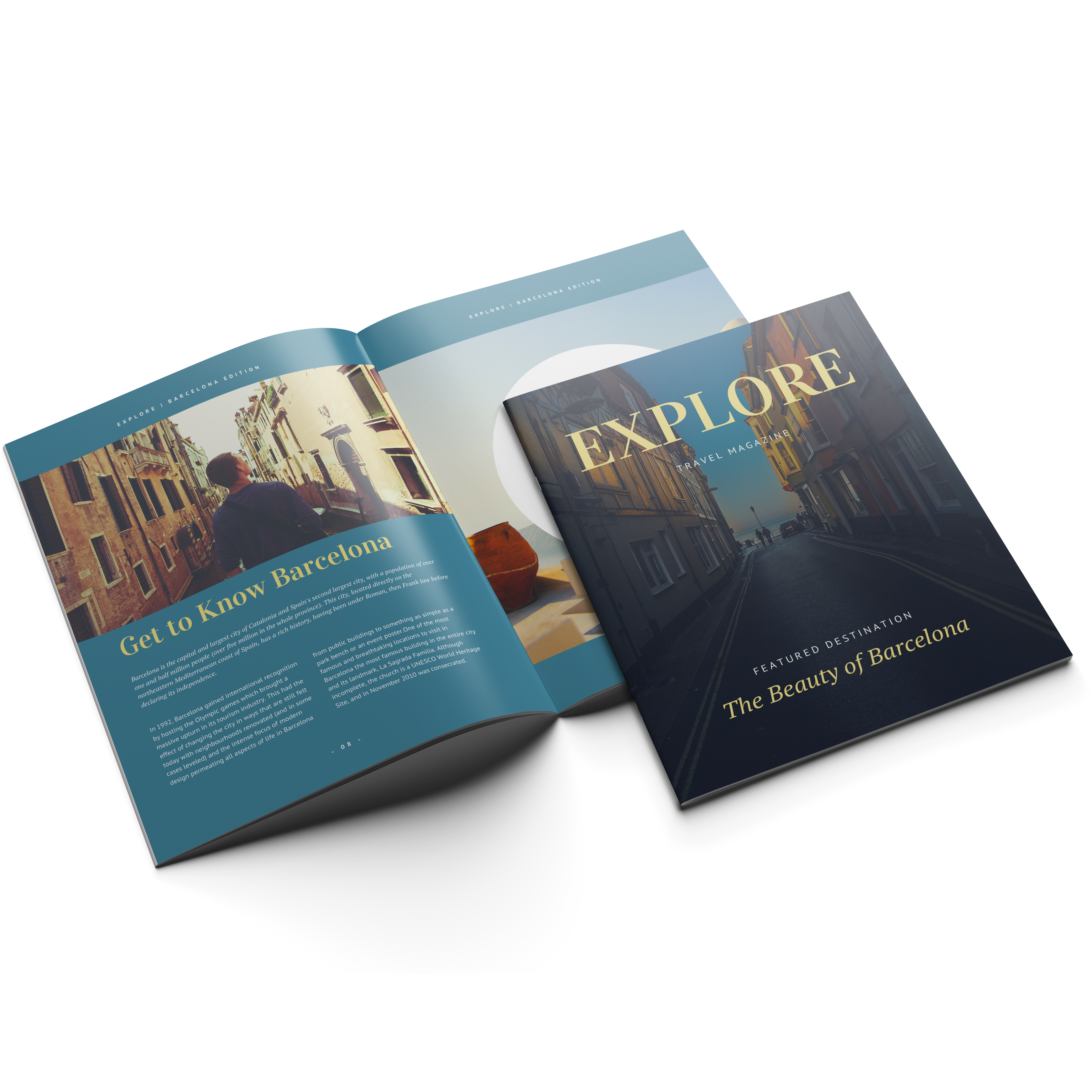
Congratulations, you’ve reached the printing stage of making a catalog! Choosing the right printer is essential to ensure your catalog is high-quality, cost-effective, and professional. When selecting a printer, look for one that offers a wide range of catalog sizes, paper stocks, and coating options to ensure your catalog is printed with the best materials while meeting your needs. Additionally, good customer service is vital so that you can get the help you need whenever questions arise, and having access to a graphic design team can be beneficial if you need design assistance.
Another important thing to consider when choosing a catalog printer is their experience in mailing services. If you plan to mail your catalogs using direct mail marketing, it’s a great idea to work with a printer that has its own mailing center. A printer with an in-house mailing center, like Kingston Printing, can save you time and money while ensuring that your catalogs reach your target audience quickly. By partnering with a printer that offers printing and mailing services, you can streamline your catalog marketing process and ensure a successful marketing campaign.
Conclusion: The Best Way to Make a Catalog
Creating a catalog may seem difficult at first, but by following the steps outlined above and taking the time to plan, you can create an eye-catching and effective marketing tool that engages your audience and drives sales.
At Kingston Printing, we offer high-quality catalog printing services, and our team is here to assist you every step of the way. Whether you need help planning your catalog, selecting specifications, or designing your materials, our team is here to help. So, when you're ready to bring your catalog to life, contact us or visit our custom quote page to start creating your most powerful marketing tool yet!
Quote Your Catalogs Now!









